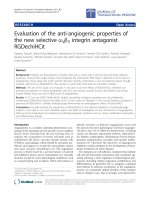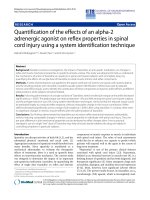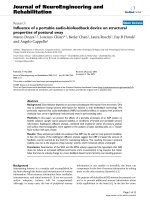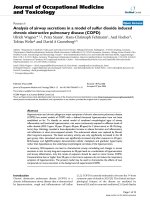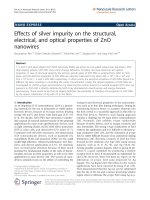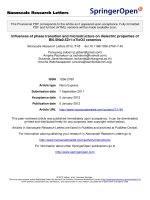Báo cáo hóa học: " Properties of silicon dioxide layers with embedded metal nanocrystals produced by oxidation of Si:Me mixture" doc
Bạn đang xem bản rút gọn của tài liệu. Xem và tải ngay bản đầy đủ của tài liệu tại đây (416.54 KB, 6 trang )
NANO EXPRESS Open Access
Properties of silicon dioxide layers with
embedded metal nanocrystals produced by
oxidation of Si:Me mixture
Andrei Novikau
1*
, Peter Gaiduk
1
, Ksenia Maksimova
2
, Andrei Zenkevich
2
Abstract
A two-dimensional layers of metal (Me) nanocrystals embedded in SiO
2
were produced by pulsed laser deposition
of uniformly mixed Si:Me film followed by its furnace oxidation and rapid thermal anneal ing. The kinetics of the
film oxidation and the structural properties of the prepared samples were investigated by Rutherford
backscattering spectrometry, and transmission electron microscopy, respectively. The electrical properties of the
selected SiO
2
:Me nanocomposite films were evaluated by measuring C-V and I-V characteristics on a metal-oxide-
semiconductor stack. It is found that Me segregation induced by Si:Me mixture oxidation results in the formation
of a high density of Me and silicide nanocrystals in thin film SiO
2
matrix. Strong evidence of oxidation temperature
as well as impurity type effect on the charge storage in crystalline Me-nanodot layer is demonstrated by the
hysteresis behavior of the high-frequency C-V curves.
Introduction
During the last decade, much attention has been focused
on the investigation o f semiconductor and metallic
nanocrystals (NCs) or nanoclusters embedded in dielec-
tric matrices. The interest is motivated by possible
applications of such nanocompo site structures. Particu-
larly, semiconductor o r metal NCs embedded in SiO
2
dielectric layer of a metal-oxide-semiconductor field-
effect transistor may replace SiN
x
floating gate in con-
ventional Flash memory devices, allowing for thinner
injection oxides, and subsequently, smaller operating
voltages, longer retention time, and faster write/erase
speeds [1-3]. The performance of such memory struc-
ture st rongly depends on the characteristics of the NCs
arrays, such as their size, shape, spatial distribution,
electronic band alignment.
Several approaches have bee n recently tested for the
formation of NCs in dielectric layers. Among those, self-
assembling of NCs in dielectric layers fabricated by the
low-energy ion implantation and different deposition
techniques has been studied by several groups [4-7]. A
strong memory effect in MOS devices using oxides with
Si or Ge NCs w as reported in [4,6]. However, the
implantation of Ge at the silicon-tunnel oxide interface
creates trap sites and results in the degradation of the
device performance [4]. The growth technique using
MBE deposition of 0.7-1 nm thick Ge layer followed by
rapid thermal processing was implemented in [8,9]. An
alternative method for Ge NCs production [10] consists
of the following steps: low pressure chemical vapor
deposition of thin Si-Ge layer, thermal wet or dry oxida-
tion, and thermal trea tmen t in an inert ambient (reduc-
tion). Recently, a method to form an ultrathin
nanocomposite SiO
2
:NC-Me layers at room temperature
by combining the deposition of Si:Me mixed layer on
the pre-oxidized Si substrate and its further oxidation in
the glow discharge oxygen plasma was proposed [11].
In this article, a similar approach was used to produce
thin SiO
2
layers with an embedded layer of metal NCs.
Au and Pt were chosen as metal components in Si:Me
mixtures since both metals are believed to catalyze Si
oxidation thus reducing the processing temperature,
while neither Au nor Pt form stable oxides. Both Pt and
Au embedded as NCs in dielectric matrix are attractive
materials in plasmonics [12]. In addition, both metals
have much higher electron work functions compared to
semiconductors, particularly, Ge, and it is interesting to
investigate the effect of the NC work function on the
* Correspondence:
1
Belarusian State University, 4 prosp. Nezavisimosti, 220030, Minsk, Belarus
Full list of author information is available at the end of the article
Novikau et al. Nanoscale Research Letters 2011, 6:148
/>© 2011 Novikau et al; licensee Springer. This is an Open Access article distributed under the terms of the Creative Commons
Attribution License (http://creativecomm ons.org/licenses/by/2.0), which permits unrestricted use, distribution, and reproductio n in
any medium, provided the original work is prop erly cited.
electrical properties of the MOS stack with embedded
NCs. As the first step, a thin Si:Me layer with the p re-
cisely pre-defined composition was grown by pulsed
laser deposition (PLD) technique. The oxidation of Si:
Me mixture was expected to result in the segregation of
the noble metal in NCs distributed in the SiO
2
matrix.
By means of analyzing the Si(O
x
):Me elemental depth
distributio ns as a function of the annea ling tempe rature
and/or time, we attempted to investigate the kinetics of
the composite structure formation. This information
was supplemented by microstructural transmission elec-
tron microscopy (TEM) analysis and further–by electri-
cal measurements on metal/SiO
2
:Me-NC/Si capacitors.
Experimental
N-type Si(001) wafers were used as substrates. The uni-
form SiO
2
layer 6 nm in thickness (tunnel oxide) was
first grown in a dry oxygen ambiance. An amorphous Si:
Me (Me = Au, Pt) layer 20 nm in thickness was then
deposited by PLD at room temperature. The computer-
ized ultra-high vacuum (base pressure P =10
-6
Pa)
home-made PLD setup e mploying YAG:Nd laser ( l =
1,064 μm) and operating in the Q-switched regime (τ =
15ns)atthevariableoutputenergiesE = 50-200 mJ
and the repetition rates ν = 5-50 Hz was employe d to
ablate from t he elemental Si and Me (M e = Au, Pt) tar-
gets. The pre-calculated composition of the Si:Me mix-
ture necessary to form the desired nanocomposite
structur e was provided by choosing the exact ratio of Si
vs. Me deposition pulses in a deposition cycle during
the Si:Me layer growth. The sandwiched Si:Me/SiO
2
/Si
samples were f urther thermally oxidized in dry oxygen
ambient. To exclude the coalescence of the segregating
metal NCs, the thermal budget should be minimized.
Therefore, to determine the minimal temperatures to
oxidize Si:Me mixtures at our conditions, the prelimin-
ary experiments were performe d. It is worth noting that
the presence of a noble metal in Si:Me mixture is found
to significantly reduce the oxidation temperatures as
compa red to pure Si. Thus, the chosen oxidation condi-
tions were T = 640-725°C for 60-540 min. Finally, the
thermally oxidized structures were subjected to rapid
thermal annealing in dry nitrogen ambient at T = 900°C
for 30 s. The sequential processing steps are shown in
Figure 1. A reference SiO
2
/Si sample with no metal NCs
was prepared for comparison.
The composition of and the metal depth distribution
in the samples were measured using Rutherford back-
scattering spectrometry (RBS) with a He
+
beam at E =
1.5 MeV. The spectra were taken simultaneously at two
different scattering angles, θ = 10° and θ =75°,withthe
former geometry being used to c alculate the integral
metal concentration in Si:Me, while the l atter one to
observe possible changes in the metal distributio n upon
oxidation. The experimental spectra were analyzed using
the RUMP software [13]. The structural quality and the
phase composition were analyzed using t he TEM in
both plain-view and cross-sectional geometries using a
Philips CM20 instrument operating at U = 200 kV.
MOS capacitors with In electrodes were fabricated, and
the high-frequency C-V measurements were carried out
using a serial HP4156B instrument.
Results and discussion
The typical RBS spectra from the as-grown and ther-
mally treated Si:Me/SiO
2
/Si samples are presented in
Figure 2. The RBS spectra show that the thickness of
as-deposited Si:Au layers is about 20 nm. The metal
concentration in the deposited layers is in the range 2.5-
4.5%. The shift of both Au and Pt peaks to the lower
energies upon thermal oxidation evidencing the pile up
of metal atoms at the SiO
2
/Si interface is clearly
observed in RBS spectra. The observed evolution of Pt
and Au concentration profiles indicates the complete
rejection of Me atoms from the oxide during ther mal
oxidation of a-S i:Me layer. The detailed analysis of RBS
data (Figure 2) reveals that Au and Pt segregation
depends on the oxidation conditions. In particular,
neither evaporation nor diffusion of Au or Pt in SiO
2
layer takes place during thermal oxidation in dry O
2
.
On the contrary, oxidation at higher temperatures
results in a strong loss (about 30%) of Me from the
SiO
2
layer, apparently due to evaporation and partial dif-
fusion into the Si substrate.
The results of the plain-view TEM investigations (pub-
lished elsewhere [14]) correlate well with the RBS data.
Figure 3a clearly shows the well-separated clust ers
embedded in the SiO
2
layer formed after thermal treat-
ment.Theaveragesizeandthearealdensityofthe
observed NCs w ere estimated to be from 10 to 20 nm
and 2 × 10
10
cm
-2
, respectively. To elucidate the struc-
tural properties of metal NCs, the HRTEM analysis was
performed. The results for SiO
2
:NC-Pt are shown in
Figure 3b. The bright-field TEM micrograph of the Si:
Pt-alloyed sample oxidized at T = 640°C for 5 h reveals
dark-gray clusters scattered on a light gray SiO
2
back-
ground. Careful examination of the clusters structure
performed using the direct resolution of crystallographic
planes and selected area electron diffraction patterns
analysis (not shown) evidences the formation of plati-
num monosilicide (PtSi) crystalline phase in NCs. In
addition, unoxidized silicon islands were also identified.
Similar results were also obtained for Si:Au samples
although no evidence of Au silicide formation was
found (not shown). A previous study [11] describing
detailed in situ investigation by X-ray photoelectron
spectroscopy of the Au chemical state evolution during
the oxidation of the similarly produced Si:Au mixture
Novikau et al. Nanoscale Research Letters 2011, 6:148
/>Page 2 of 6
Si
*
*
*
*
*
*
*
O
1
SiO
2
.
.
.
.
.
•
••
Si+Au
.
.
Si
2
SiO
2
Si+Au
*
*
*
*
*
*
O
Si
3
SiO
2
Si
~30 nm
~10 nm
NC-Me (Me:Au, Pt)
4
Figure 1 The proposed procedure of the MOS stack formation including SiO
2
layers with the embedded metal NCs.
200 250 300 350 400 450 500
0
200
400
600
800
1000
1200
500 600 700 800 900 1000 1100 1200 1300 1400
E
nergy,
K
e
V
Pt
Si
O
A
Si:Pt
as grown
oxidation 60 min at 725
0
C
Normalized Yield
Channel
200 250 300 350 400 450 500
0
200
400
600
800
1000
1200
500 600 700 800 900 1000 1100 1200 1300 1400
Energy, KeV
B
Si:Au
as grown
oxidation 60 min at 725
0
C
oxidation 60 min at 650
0
C
Normalized Yield
C
h
a
nn
e
l
O
Si
Au
Figure 2 RBS spectra from as grown and thermally oxidized Si:Me/SiO
2
/Si samples: (a) RBS spectra (E = 1.5 MeV, θ = 75°) from Si:Pt/SiO
2
/Si
samples thermally oxidized at T = 725°C for 60 min in O
2
followed by thermal annealing in N
2
at T = 900°C for 30 s. as compared with as-grown
structure; (b) Au peak in RBS spectra evidences strong Au segregation during Si oxidation process at different temperatures.
Novikau et al. Nanoscale Research Letters 2011, 6:148
/>Page 3 of 6
indicated the formation of a metastable Au silicide dur-
ing the room temperature deposition and its further
decomposition to metallic Au upon oxidation.
The self-assembling phenomenon of the formation of
metal and silicide NCs in SiO
2
can be explained using
two mechanisms. A solubility of impurities in SiO
2
is
quite low, and therefore the structures obtained after
metal segregation and piling up between two SiO
2
layers
(tunnel oxide and SiO
2
capping layer) were transformed
into the supersaturated solution. It is well known that
under the thermal treatment the decomposition of
supersaturated solution takes place eventually resulting
in the phase separation and the formation of the metal
NCs in a dielectric (oxide) matrix. On the next stage,
the Ostwald ripening of the formed NCs occurs. This
implies the diffusion of metal atoms from the valley
regions of the islands toward their respective centers
forming spherical nanocrystals to achieve greater
volume-to-surfac e ratio. In our mo del, the initial NCs
are formed during the oxidation of the Si:Me layer.
After the oxid ation is completed, the sample is still kept
at elevated temperature facilitating the coalescence of
Me NCs.
The effect of the oxidation temperature as well as the
type of the embedded Me on the efficiency of the charge
storage was studied by the high-frequency C-V measure-
ments. The hysteresis in C-V curves was found different
for the structures containing Au and PtSi NCs (Figure 4).
The maximal value of the flat-band voltage shift U = 1.8
VfortheV
g
sweep -5/+3 V was obtained for SiO2:NC-
Au based structures prepared by dry oxidation. On the
contrary, in the case of SiO
2
:NC-PtSi, the maximal flat-
band voltage shift was U = 1.2 V. By increasing V
g
sweep up to 5 V, a gradual increase of the flat-band vol-
tage shift was achieved. Since high positive gate voltages
shift C-V curves in the direction of the stored negative
charges, it is concluded that the charge trapping occurs
through the elec tron injection from the substrate into
the oxide. No flat-band voltage shift was observed for
the reference sample prepared with pure SiO
2
,oxidized
at T = 850°C for 60 min in O
2
ambient. It is therefore
concluded that the effect of charge storage is related to
the NCs.
One of the major reasons for the loss of charge in the
floating gate structures is the leakage current. The me a-
sured I-V curves (Figure 5) from Si:Au and Si:Pt samples
oxidized in dry ambient reveal that the leakage current
density can be reduced down to 10
-8
A/cm
2
.Thelow
leakage currents achieved are explained by the high
quality of both tunneling and capping oxide formed by
dry thermal process compared with the deposited oxides
used in the alternative methods of MOS capac itor for-
mation [15]. It is found that the oxidation temperature
has also a strong effect on the leakage current, and
therefore the oxidation conditions should be optimized
for each type of embedded metal NCs.
Conclusion
In this study, the authors have demonstrated the growth
of thin SiO
2
layers with embedded metal and metal sili-
cide NCs by the combination of Si:Me mixture by PLD at
room temperature and its thermal oxidation. By means
of this fabrication technique, it is possible to produce a
sheet of crystalline metal n anocrystals at any desirable
depth in the oxide. The metal segregation process during
thermal oxidation results in the formation of a high areal
density of crystalline Au and PtSi dots 10-20 nm in dia-
meter which are distributed in the silicon dioxide at a
distance of 5-6 nm from the crystalline Si substrate. The
charge storage effect is evide nt from C-V characteristics
Figure 3 Transmission electron microscopy analysis from a Si:Pt sample, oxidized at T = 640°C for 5 h in dry O2: bright-field plain-
view (a) and high resolution (b) TEM images. Crystalline PtSi NCs exhibit a dark contrast on the gray background of the SiO
2
layer.
Novikau et al. Nanoscale Research Letters 2011, 6:148
/>Page 4 of 6
on MOS capacitors, and the results indicate the injection
of the electrons from the substrate. The flat-band voltage
shift of about 1.2-1.8 V for V
g
sweepsof-5/+3Vis
achieved. It is shown that the leakage current density
depends mostly upon the oxidation conditions, and for
both types of metal NCs (Au and PtSi), it was measured
to be around 10
-8
A/cm
2
. The reproducibility and the
precision of the proposed fabrication technique (PLD
and thermal treatment) to produce a 2 D array of well-
separated nanocrystals in a SiO
2
layer suggest that this
-5 -4 -3 -2 -1 0 1 2 3
4
6
8
10
12
14
16
18
20
-5 -4 -3 -2 -1 0 1 2
3
4
6
8
10
12
14
16
18
20
22
24
26
28
30
SiPt
oxidation 9 h, 640
0
ɋ
oxidation 5 h, 640
0
ɋ
C
SiO
2
, pF
Gate volta
g
e, V
SiAu
oxidation 9 h, 640
0
C
oxidation 5 h, 640
0
C
Figure 4 High-frequency C-V curves measured from Si:Au and Si:Pt samples, oxidized at T =640°Cfor5and9hindryO
2
,
respectively. A gate voltage sweep from inversion to accumulation and from accumulation to inversion is shown on the figure by arrows.
024681012
1E-9
1E-8
1E-7
1E-6
1E-5
1E-4
Si/SiO
2
structure with pure SiO
2
Oxidation at 640
0
C
SiPt, 9 hours
SiPt, 5 hours
SiAu, 9 hours
SiAu, 5 hours
Leakage current density, Ⱥ/ɫm
2
Gate volta
g
e, V
Figure 5 Leakage current vs. gate volt age characteristics obtained from the oxidi zed Si:Au a nd Si:Pt samples at T = 640°C.TheI-V
curve from the reference sample of pure SiO
2
is shown for comparison.
Novikau et al. Nanoscale Research Letters 2011, 6:148
/>Page 5 of 6
method can be applied for the f abrication of functional
MOS structures.
Abbreviations
NCs: nanocrystals; PLD: pulsed laser deposition; RBS: Rutherford
backscattering spectrometry; TEM: transmission electron microscopy; MOS:
metal-oxide-semiconductor.
Acknowledgements
We would like to acknowledge the help received from A. Orekhov (Institute
of Crystallography, RAS) for high resolution TEM analysis.
This study is a part of the Belarusian Scientific Research Program
“Electronics” and was funded also by the Belorussian and Russian
Foundations for Fundamental Research (projects T08P-184/90023).
Author details
1
Belarusian State University, 4 prosp. Nezavisimosti, 220030, Minsk, Belarus
2
NRNU “Moscow Engineering Physics Institute”, 31 Kashirskoe shausse,
115409, Moscow, Russian Federation
Authors’ contributions
AN participated in the RBS analysis and carried out the electrical
characterization, participated in the design of the study and drafted the
manuscript. KM carried out the pulsed laser deposition and experimental
data analysis. PG conceived of the study, and participated in its design and
coordination. AZ participated in the design of the study, coordinated TEM
analysis and significantly contributed to the writing of manuscript. All
authors read and approved the final manuscript.
Competing interests
The authors declare that they have no competing interests.
Received: 21 September 2010 Accepted: 16 February 2011
Published: 16 February 2011
References
1. Kwon YH, Park CJ, Lee WC, Fu DJ, Shon Y, Kang TW, Hong CY, Cho HY,
Wang KL: Memory effects related to deep levels in metal-oxide-
semiconductor structure with nanocristalline Si. Appl Phys Lett 2002,
80:2502.
2. Tiwari S, Rana F, Hanafi H, Hartstein A, Crabbe EF, Chan K: A silicon
nanocrystals based memory. Appl Phys Lett 1996, 68:1377.
3. Tiwari S, Rana F, Chan K, Shi L, Hanafi H: Single charge and confinement
effect in nanocrystal memories. Appl Phys Lett 1996, 69:1232.
4. Normand P, Kapetanakis E, Dimitrakis P, Tsoukalas D, Beltsios K, Cherkasin N,
Bonafos C, Benassayag G, Coffin H, Claverie A, Soncini V, Agarwai A,
Ameen A: Effect of annealing enviroment on the memory properties of
thin oxides with embedded Si nanocrystals obtained by low-energy ion-
beam synthesis. Appl Phys Lett 2003, 83:168.
5. Beyer V, von Borany J: Elemental redistribution and Ge loss during ion-
beam synthesis of Ge nanocrystals in SiO2 films. Phys Rev B 2008,
77:014107.
6. Baron T, Pelissier B, Perniola L, Mazen F, Hartman JM, Rolland G: Chemical
vapor deposition of Ge nanocrystals on SiO2. Appl Phys Lett 2003,
83:1444.
7. Choi WK, Chim WK, Heng CL, Teo LW, Ho V, Ng V, Antoniadis DA,
Fitzgerald EA: Observation of memory effect in Germanium nanocrystals
enbedded in an amorphous silicon oxide matrix of a metal-oxide-
semiconductor structure. Appl Phys Lett 2002, 80:2014.
8. Kanjilal A, Hansen JL, Gaiduk P, Larsen AN, Cherkashin N, Claverie A,
Normand P, Kapelanakis E, Skaratos D, Tsoukalas D: Structural and
electrical properties of silicon dioxide layers with embedded Germanium
nanocrystals grown by molecular beam epitaxy. Appl Phys Lett 2003,
82:1212.
9. Kanjilal A, Hansen JL, Gaiduk P, Larsen AN, Normand P, Dimitrakis P,
Tsoukalas D, Cherkashin N, Claverie A: Size and aerial density distributions
of Ge nanocrystals in a SiO2 layer produced by molecular beam epitaxy
and rapid thermal processing. Appl Phys A 2005, 81:363.
10. Novikau AG, Gaiduk PI, Pshenichnij EN, Nalivaijko OYu, Malishev VS,
Plebanovich VI: Nanocrystal floating gate produced by CVD and thermal
processing. Proceedings of the ICMNE, Moscow, Zvenigorod, Russia 2007,
0000:O3-O2.
11. Zenkevich AV, Lebedinskii YuYu, Timofeyev AA, Isayev IA, Tronin VN:
Formation of ultrathin nanocomposite SiO2:nc-Au structure by pulsed
laser deposition. Appl Surf Sci 2009, 255:5355.
12. Atwater HA, Polman A: Plasmonics for improved photovoltaic devices.
Nat Mater 2010, 9:205.
13. Computer Graphic Service. [].
14. Maksimova K, Matveev Yu, Zenkevich A, Nevolin V, Novikov A, Gaiduk P,
Orekhov A: Investigation of nanocomposite SiO2:Me structures, formed
by metal segregation during thermal oxidation of Si:Me alloy layers.
Perspektivnye Materialy 2010, 2:33, (in Russian).
15. Tan Z, Samanta SK, Yoo WJ, Lee S: Self-assembly of Ni nanocrystals on
HfO2 and N-assisted Ni confinement for nonvolatile memory
application. Appl Phys Lett 2005, 86:013107.
doi:10.1186/1556-276X-6-148
Cite this article as: Novikau et al.: Properties of silicon dioxide layers
with embedded metal nanocrystals produced by oxidation of Si:Me
mixture. Nanoscale Research Letters 2011 6:148.
Submit your manuscript to a
journal and benefi t from:
7 Convenient online submission
7 Rigorous peer review
7 Immediate publication on acceptance
7 Open access: articles freely available online
7 High visibility within the fi eld
7 Retaining the copyright to your article
Submit your next manuscript at 7 springeropen.com
Novikau et al. Nanoscale Research Letters 2011, 6:148
/>Page 6 of 6
